Peeping tomism plays a pivotal role in the elegant world of Murasaki Shikibu's "The Tale of Genji," Doris Bargen argues in her new book, "Mapping Courtship and Kinship in Classical Japanese." This may surprise readers as much as the argument in her 1997 monograph, "A Woman's Weapon." In that erudite book, she refuted the traditional understanding of mononoke ("spirit possession") in Shikibu's grand romance. Mononoke is the spirit central to such haunting noh plays as "Aoi no Ue."
Mapping Courtship and Kinship in Classical Japan, by Doris G. Bargen
371 pages
University of Hawaii Press, Nonfiction.
The original Japanese word for "peeping tomism" is kaimami ("looking through a gap in the fence"). It doesn't necessarily presuppose a fence or a woman, as it means "furtive observation." At any rate, it often works as a trigger to courtship in "The Tale of Genji." The Kyoto aristocracy depicted in the novel is a closed and close society, and polygamous. What Bargen calls "affinal incest" is prevalent, rampant.
At the time when the book was written, sexual acts were open, sometimes blatant. So you might say Murasaki Shikibu needed the softening glow of kaimami to romanticize the rather sordid reality she had to tell. Bargen provides sumptuous reproductions of kaimami paintings of later periods: pictures of palatial interiors, and diagrams of the relations among the characters in "The Tale of Genji." These diagrams help the reader disentangle the complicated web of sexual relationships that Genji, an emperor's semi-illegitimate son, weaves as he wanders from one woman to another, creating sorrow, heartbreak, jealousy and resignation.



















With your current subscription plan you can comment on stories. However, before writing your first comment, please create a display name in the Profile section of your subscriber account page.